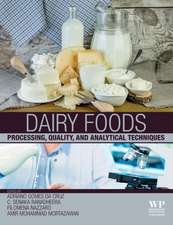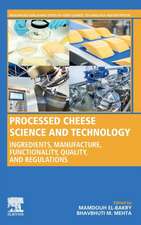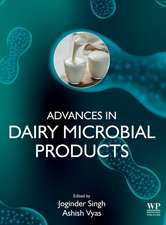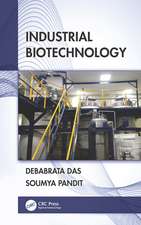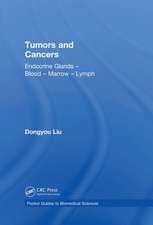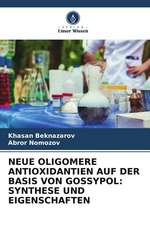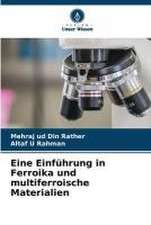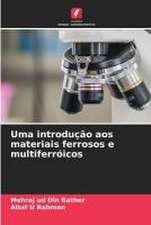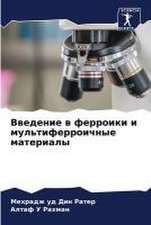Molecular Food Microbiology: Food Microbiology
Editat de Dongyou Liuen Limba Engleză Paperback – 4 oct 2024
Forming part of the Food Microbiology series, Molecular Food Microbiology provides a state of art coverage on molecular techniques applicable to food microbiology. While the introductory chapter contains an overview on the principles of current DNA, RNA and protein techniques and discusses their utility in helping solve practical problems that food microbiology is facing now and in the future, the remaining chapters present detailed moleuclar analyses of selective foodborne viruses, bacteria, fungi and parasites.
Key Features:
- Contains a state of art overview on moleuclar techniques applicable to food microbiology research and development
- Presents in-depth molecular analysis of selective foodborne viruses, bacteria, fungi and parasites
- Highlights the utility of molecular tecniques for accurate diagnosis and effective control of foodborne diseases
- Includes expert contributions from international scientists involved in molecular food microbiology research
- Represents a highly informative textbook for students majoring in food, medical, and veterinary microbiology
- Offers a contemporary reference for scholars and educators wishing to keep abreast with the latest developments in molecular food microbiology
| Toate formatele și edițiile | Preț | Express |
|---|---|---|
| Paperback (1) | 395.07 lei 6-8 săpt. | |
| CRC Press – 4 oct 2024 | 395.07 lei 6-8 săpt. | |
| Hardback (1) | 1217.97 lei 3-5 săpt. | +52.34 lei 4-10 zile |
| CRC Press – 12 apr 2021 | 1217.97 lei 3-5 săpt. | +52.34 lei 4-10 zile |
Preț: 395.07 lei
Preț vechi: 534.22 lei
-26% Nou
Puncte Express: 593
Preț estimativ în valută:
75.60€ • 79.13$ • 62.92£
75.60€ • 79.13$ • 62.92£
Carte tipărită la comandă
Livrare economică 31 martie-14 aprilie
Preluare comenzi: 021 569.72.76
Specificații
ISBN-13: 9780367740672
ISBN-10: 0367740672
Pagini: 464
Ilustrații: 87
Dimensiuni: 178 x 254 mm
Greutate: 0.86 kg
Ediția:1
Editura: CRC Press
Colecția CRC Press
Seria Food Microbiology
Locul publicării:Boca Raton, United States
ISBN-10: 0367740672
Pagini: 464
Ilustrații: 87
Dimensiuni: 178 x 254 mm
Greutate: 0.86 kg
Ediția:1
Editura: CRC Press
Colecția CRC Press
Seria Food Microbiology
Locul publicării:Boca Raton, United States
Public țintă
Professional ReferenceCuprins
SERIES PREFACE
PREFACE
CONTRIBUTORS
EDITOR
Chapter 1 Molecular food microbiology: an overview
Section I Molecular analysis and manipulation of foodborne viruses
Chapter 2 Molecular mechanisms of norovirus adhesion to agri-food surfaces and fresh foods
Chapter3 Molecular mechanisms of prion invasion and analytical methods for detection
Chapter 4 Molecular pathogenesis of Nipah virus infection
Chapter 5 Molecular identification of human bocavirus
Chapter 6 Molecular epidemiology of human polyomaviruses
Chapter 7 Genetics of emerging human coronaviruses
Chapter 8 Molecular mechanisms of host immune responses to rotavirus
Chapter 9 Development of vaccines for avian influenza virus
Chapter 10 Genetic manipulation of human adenovirus
Section II Molecular analysis and manipulation of foodborne bacteria
Chapter 11 Molecular mechanisms of Listeria stress responses
Chapter 12 Molecular pathogenesis of Aeromonas infection
Chapter 13 Molecular identification of Campylobacter spp.
Chapter 14 Molecular epidemiology of Salmonella
Chapter 15 Genomic and transcriptomic analyses of Vibrio infection
Chapter 16 Genetic manipulation of Escherichia coli
Section III Molecular analysis and manipulation of foodborne fungi
Chapter 17 Molecular pathogenesis of Encephalitozoon infection
Chapter 18 Molecular detection and quantification of aflatoxin-producing molds
Chapter 19 Molecular identification and subtyping of toxigenic and pathogenic Penicillium and Talaromyces
Chapter 20 Population genetics of Enterocytozoon bienneusi
Chapter 21 Molecular mechanisms of antifungal resistance in Candida
Chapter 22 Genetic manipulation and genome editing of Saccharomyces cerevisiae
Section IV Molecular analysis and manipulation of foodborne parasites
Chapter 23 Acanthamoeba adhesion
Chapter 24 Molecular mechanisms of Toxoplasma gondii invasion
Chapter 25 Molecular pathogenesis of Sarcocystis infection
Chapter 26 Molecular pathogenesis of Trichinella spiralis infection
Chapter 27 Molecular identification of Cyclospora cayetanensis
Chapter 28 Anisakis: from molecular identification to omic studies
Chapter 29 Molecular epidemiology of Dientamoeba fragilis
Chapter 30 Molecular epidemiology of Echinococcus spp.
Chapter 31 Proteomic analysis of Giardia infection
Chapter 32 Metabolomic analysis of Fasciola infection
Chapter 33 Molecular mechanisms of host immune responses to Entamoeba
Chapter 34 Molecular control of Taenia solium cysticercosis
Chapter 35 Genetic manipulation of Cryptosporidium
PREFACE
CONTRIBUTORS
EDITOR
Chapter 1 Molecular food microbiology: an overview
Section I Molecular analysis and manipulation of foodborne viruses
Chapter 2 Molecular mechanisms of norovirus adhesion to agri-food surfaces and fresh foods
Chapter3 Molecular mechanisms of prion invasion and analytical methods for detection
Chapter 4 Molecular pathogenesis of Nipah virus infection
Chapter 5 Molecular identification of human bocavirus
Chapter 6 Molecular epidemiology of human polyomaviruses
Chapter 7 Genetics of emerging human coronaviruses
Chapter 8 Molecular mechanisms of host immune responses to rotavirus
Chapter 9 Development of vaccines for avian influenza virus
Chapter 10 Genetic manipulation of human adenovirus
Section II Molecular analysis and manipulation of foodborne bacteria
Chapter 11 Molecular mechanisms of Listeria stress responses
Chapter 12 Molecular pathogenesis of Aeromonas infection
Chapter 13 Molecular identification of Campylobacter spp.
Chapter 14 Molecular epidemiology of Salmonella
Chapter 15 Genomic and transcriptomic analyses of Vibrio infection
Chapter 16 Genetic manipulation of Escherichia coli
Section III Molecular analysis and manipulation of foodborne fungi
Chapter 17 Molecular pathogenesis of Encephalitozoon infection
Chapter 18 Molecular detection and quantification of aflatoxin-producing molds
Chapter 19 Molecular identification and subtyping of toxigenic and pathogenic Penicillium and Talaromyces
Chapter 20 Population genetics of Enterocytozoon bienneusi
Chapter 21 Molecular mechanisms of antifungal resistance in Candida
Chapter 22 Genetic manipulation and genome editing of Saccharomyces cerevisiae
Section IV Molecular analysis and manipulation of foodborne parasites
Chapter 23 Acanthamoeba adhesion
Chapter 24 Molecular mechanisms of Toxoplasma gondii invasion
Chapter 25 Molecular pathogenesis of Sarcocystis infection
Chapter 26 Molecular pathogenesis of Trichinella spiralis infection
Chapter 27 Molecular identification of Cyclospora cayetanensis
Chapter 28 Anisakis: from molecular identification to omic studies
Chapter 29 Molecular epidemiology of Dientamoeba fragilis
Chapter 30 Molecular epidemiology of Echinococcus spp.
Chapter 31 Proteomic analysis of Giardia infection
Chapter 32 Metabolomic analysis of Fasciola infection
Chapter 33 Molecular mechanisms of host immune responses to Entamoeba
Chapter 34 Molecular control of Taenia solium cysticercosis
Chapter 35 Genetic manipulation of Cryptosporidium
Notă biografică
Dongyou Liu, Ph.D., studied veterinary science at Hunan Agricultural University, China and conducted postgraduate research on the generation and application of monoclonal antibodies for improved immunodiagnosis of human hydatidosis at School of Veterinary Science, University of Melbourne, Australia. In the past three decades, he has worked at several research and clinical laboratories in Australia and the United States of America, with focuses on molecular characterization of microbial pathogens and detection of human genetic disorders and tumors/cancers. He is the first author of >50 original research and review articles in peer-reviewed international journals, the contributor of 275 book chapters, and the editor of "Handbook of Listeria monocytogenes" (2008), "Handbook of Nucleic Acid Purification" (2009), "Molecular Detection of Foodborne Pathogens" (2009), "Molecular Detection of Human Viral Pathogens" (2010), "Molecular Detection of Human Bacterial Pathogens" (2011), "Molecular Detection of Human Fungal Pathogens" (2011), "Molecular Detection of Human Parasitic Pathogens" (2012), "Manual of Security Sensitive Microbes and Toxins" (2014), "Molecular Detection of Animal Viral Pathogens" (2016), "Laboratory Models for Foodborne Infections" (2017), "Handbook of Foodborne Diseases" (2018), and "Handbook of Tumor Syndromes" (2020), all of which are published by CRC Press. He is also a co-editor for "Molecular Medical Microbiology 2nd edition" (2014), which is released by Elsevier. Further, he is the author of recent CRC books: "Pocket Guides to Biomedical Sciences: Tumors and Cancers – Central and Peripheral Nervous Systems" (2017), "Pocket Guides to Biomedical Sciences: Tumors and Cancers – Head, Neck, Heart, Lung and Gut" (2017), "Pocket Guides to Biomedical Sciences: Tumors and Cancers – Skin, Soft Tissue, Bone and Urogenitals" (2017), and "Pocket Guides to Biomedical Sciences: Tumors and Cancers – Endocrine glands, Blood, Marrow and Lymph" (2017).
Descriere
Forming part of the Food Microbiology series, this book provides a state of art coverage on molecular techniques applicable to food microbiology.







